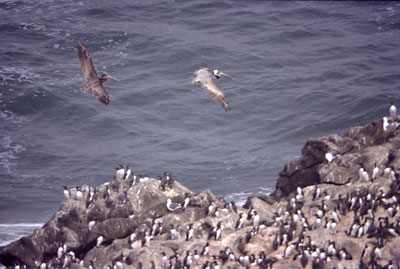Species of Concern Profile: Brown Pelican
September 2005
Watching Brown Pelicans can turn a simple beach trip into an extraordinary event. A perfect line formation of these large, prehistoric-looking birds is becoming a more common sight in the Northwest.
When they dive, the fun really starts. Folding their wings back, pelicans sight along the bill as they plunge into the water, breaking their torpedo-like progress by gaping wide. Aptly named pouchbills by COASST, they are one of two pelican species in North America and are closely related to the more ubiquitous cormorants.

Brown Pelicans pass over a murre colony in Oregon (Nathalie Hamel)
Nesting in trees and shrubs by the thousands, pelican colonies are an oddly quiet place. Adults are silent, relying on the flash of breeding plumage and waggle of their reddened bill pouch to attract mates. Unlike gull chicks who are quickly up and around, pelican chicks stay in the nest for weeks. But after a two-month diet of anchovies—hold the pizza—most are ready to fledge and begin life on their own.
Once a critically endangered species protected under the Endangered Species Act, the West Coast population of Brown Pelicans Pelecanus occidentalis californicus came close to the brink of extinction because of pesticide poisoning. Pelicans were accumulating DDT and its breakdown products through a process known as bio-magnification. Pesticides entering the marine foodchain were concentrated at each level: plankton to fish to marine birds. Because DDT interferes with calcium production, females began to produce thinner eggs, and parents inadvertently crushed their offspring while attempting to incubate. By the 1970s, entire colonies were failing to produce any young.
Rachel Carson’s book Silent Spring documented the impacts of pesticides on birds throughout North America and helped launch the successful campaign to ban DDT in the US in 1972. Today, pelican eggshells are much thicker—only 4–5% thinner than normal—and successful reproduction is again the norm.
But these ancient birds are not quite “out of the water” yet. They breed on only six main islands along the West Coast—two off southern California and four in the Gulf of California off the Mexican coast. Even a small amount of human disturbance at a colony, an oil spill in the nearshore environment, or a decrease in forage fish availability can cause a hiccup in the recovery of this species.
A voracious hunter of silvery schooling fish, a Brown Pelican can consume up to four pounds of fish in a typical day. Anchovies and sardines—the fish of Cannery Row fame—are a favorite food. These days, pesticides and fishers are minor concerns for pelican recovery relative to climate events that alter forage fish populations. If the anchovy population takes a dip during an El Niño, the number of pelicans returning to breed can drop by two thirds!
Moreover, the picture isn’t always simple: in 2004, the food supply was good during the breeding season, but diminished right after the chicks were fledged and on their own for feeding. Many young birds were found starving and begging for food at docks and wharfs. Some traveled inland as far as Arizona in search of food. Many perished, fooled into doing kamikaze flights onto the water mirages of hot, shiny pavement.
More than a quarter century after they were first listed, the West Coast population of Brown Pelicans is still on the Federal endangered species list. But this scrappy and often comical bird is a conservation success story. On Anacapa Island—the main pelican breeding colony on the West Coast of the US—the population has climbed from a low of less than 100 pairs in the 1970s to over 6,000 pairs by 2004. In recent years, East Sand Island at the mouth of the Columbia River has been a popular roosting area for Brown Pelicans, and may represent the beginning of a Pacific Northwest breeding colony. And so, as you walk your beaches, look for a squadron of pelicans overhead.